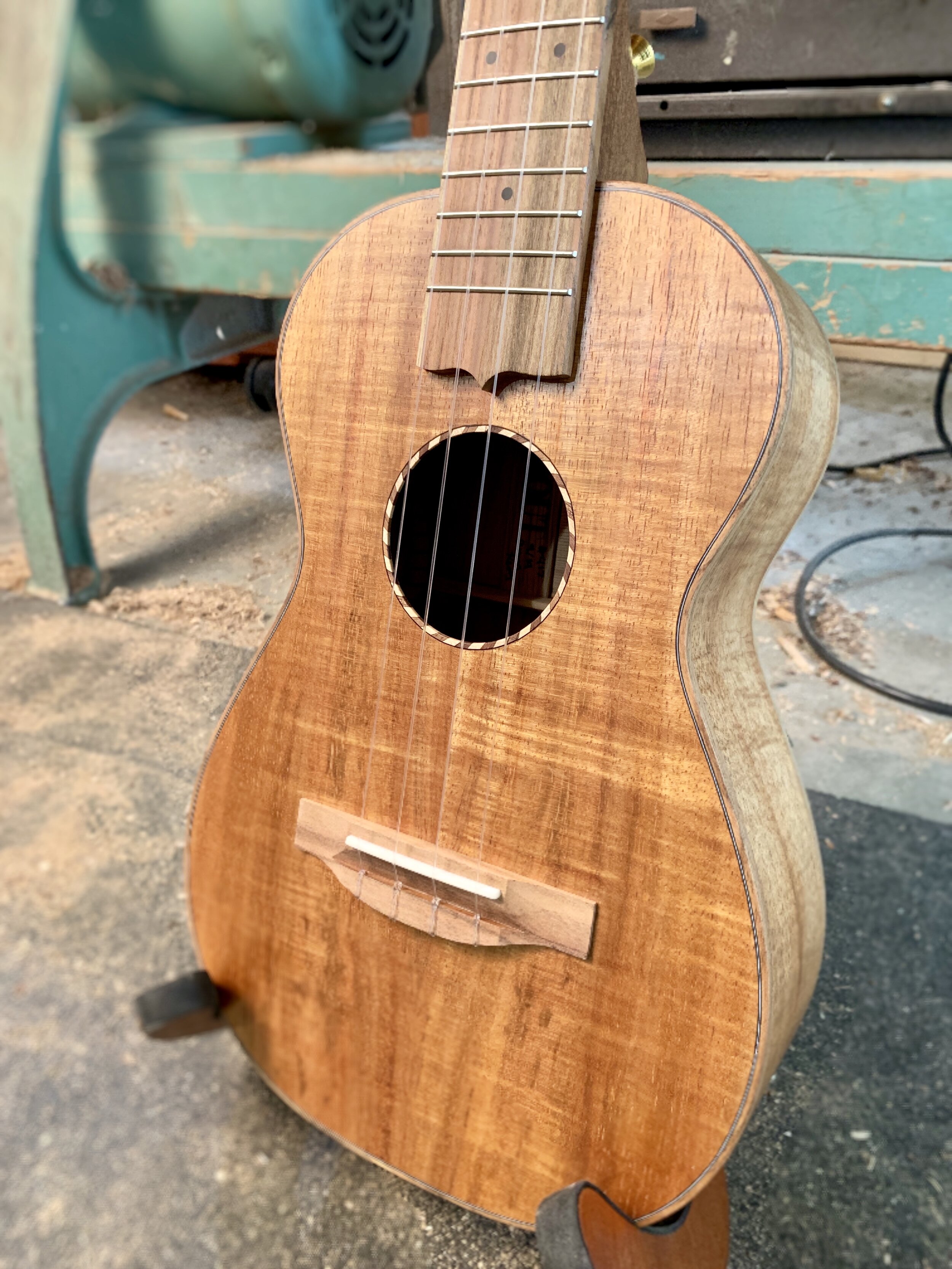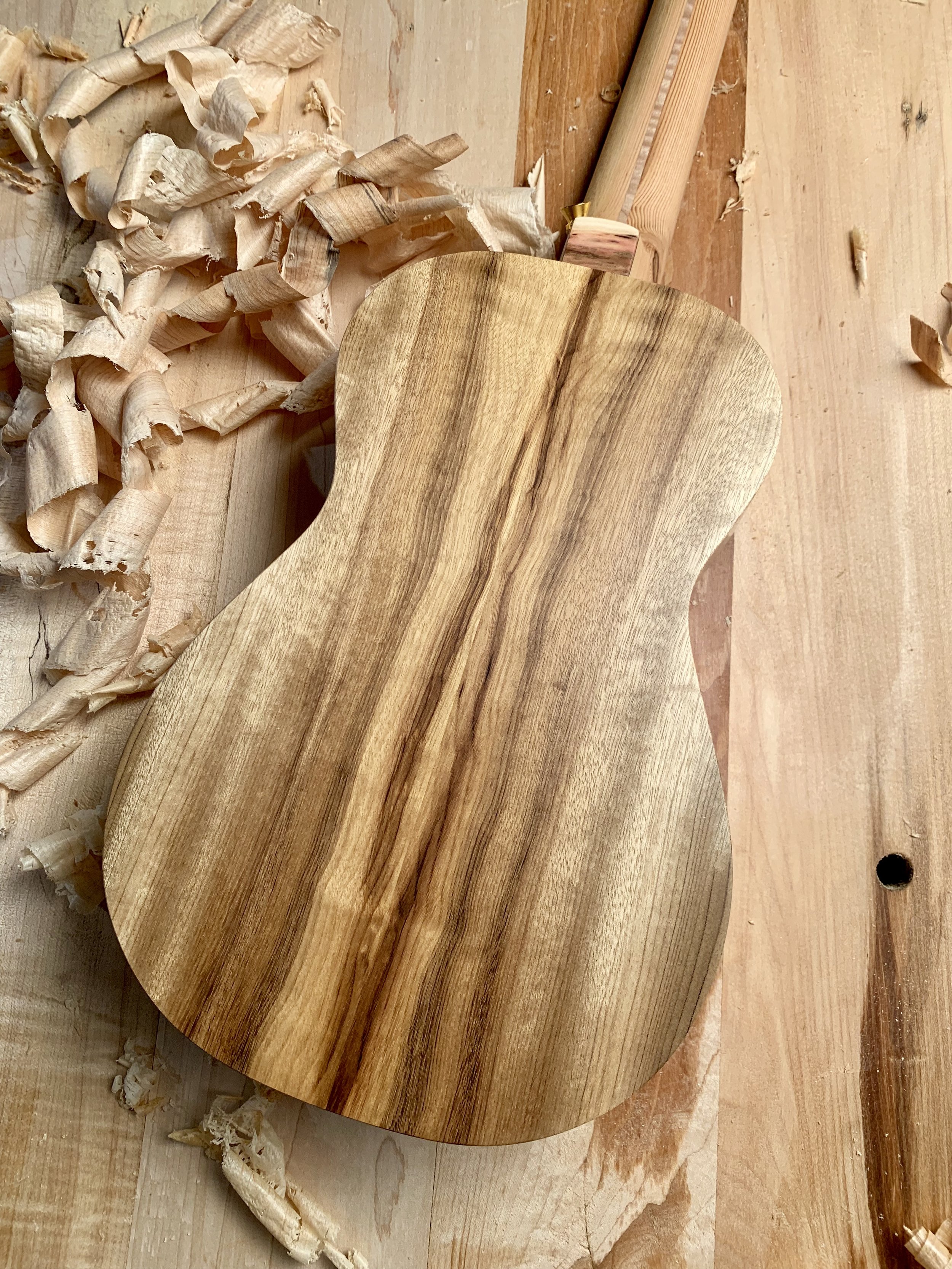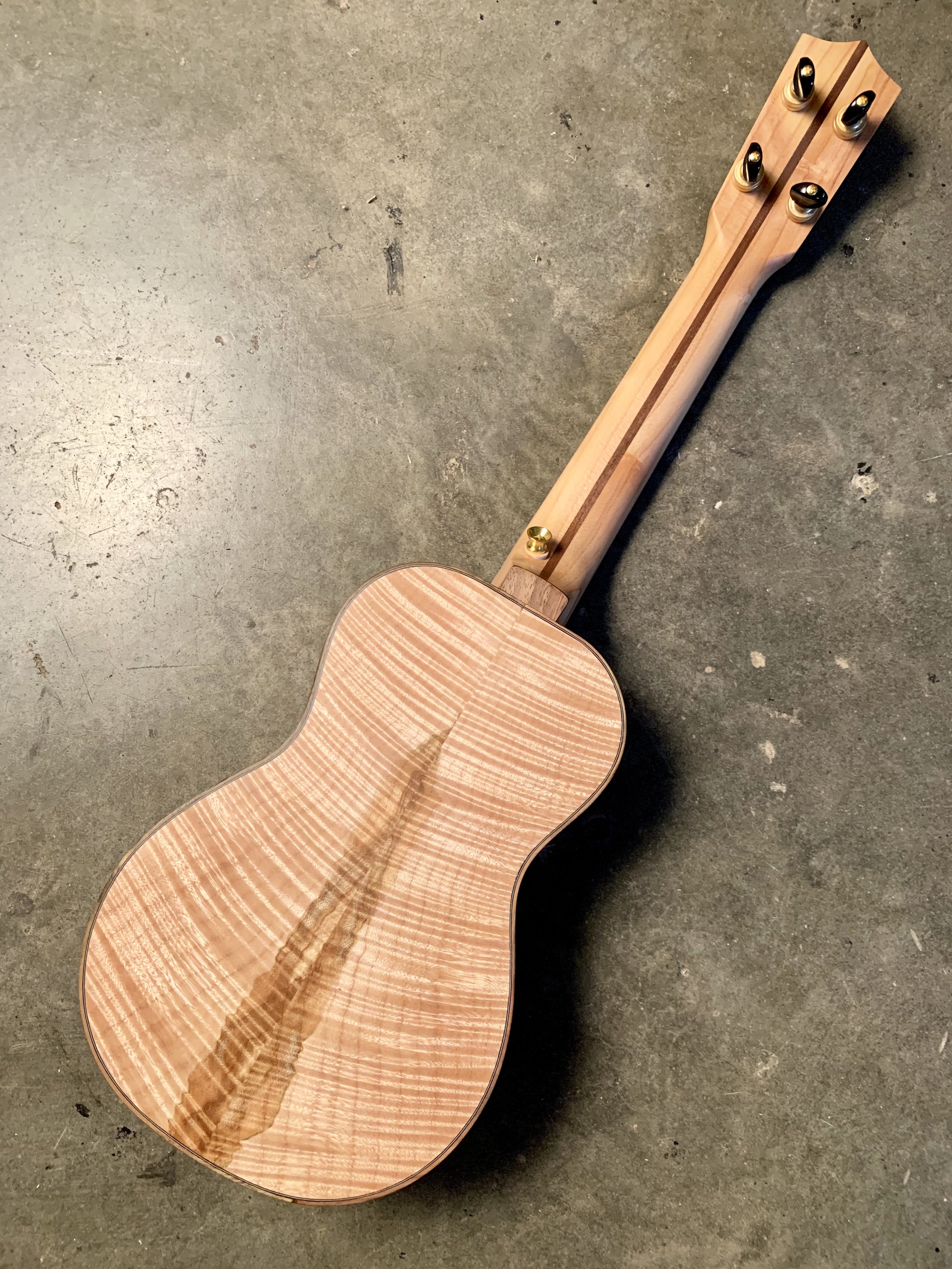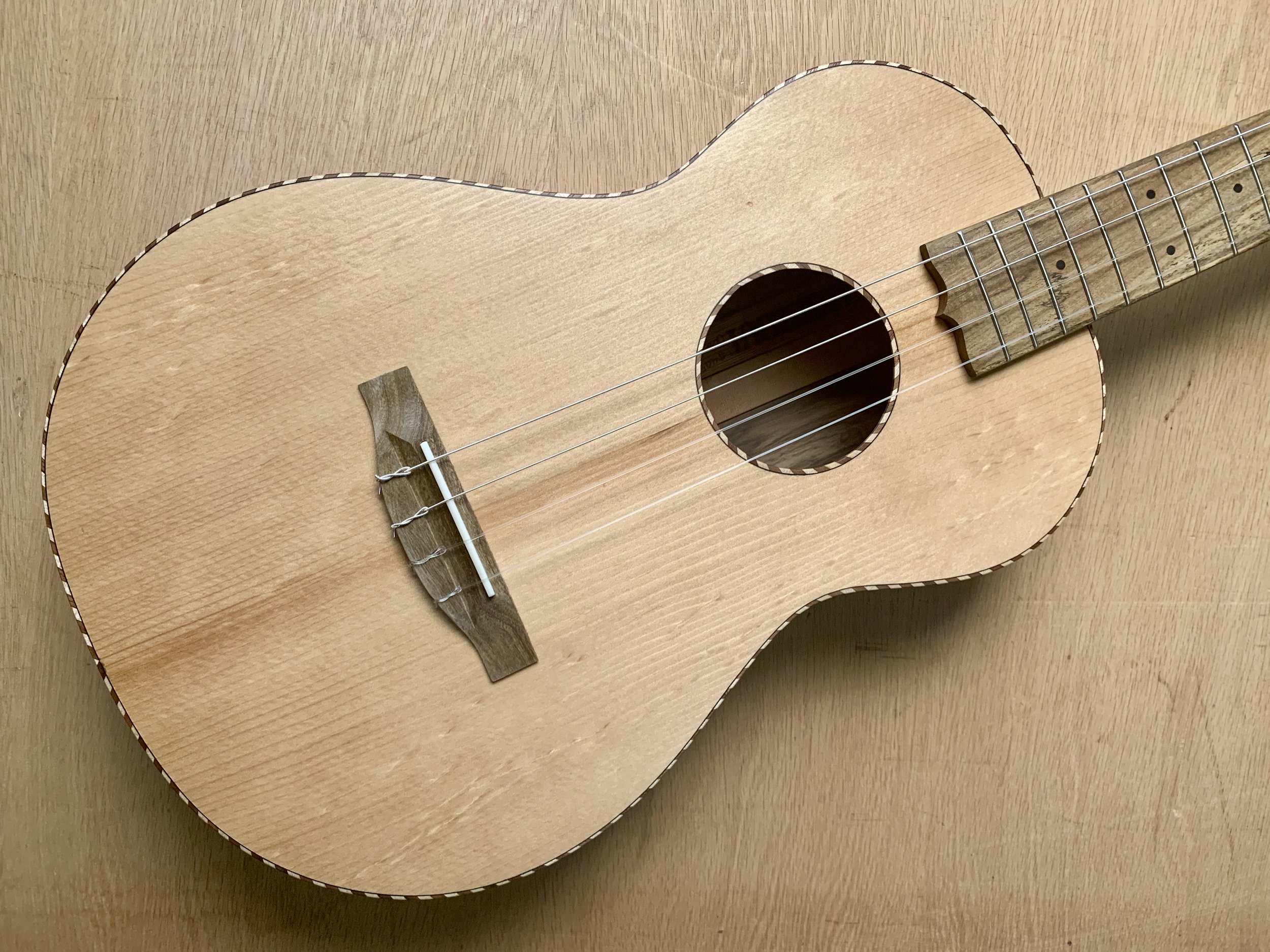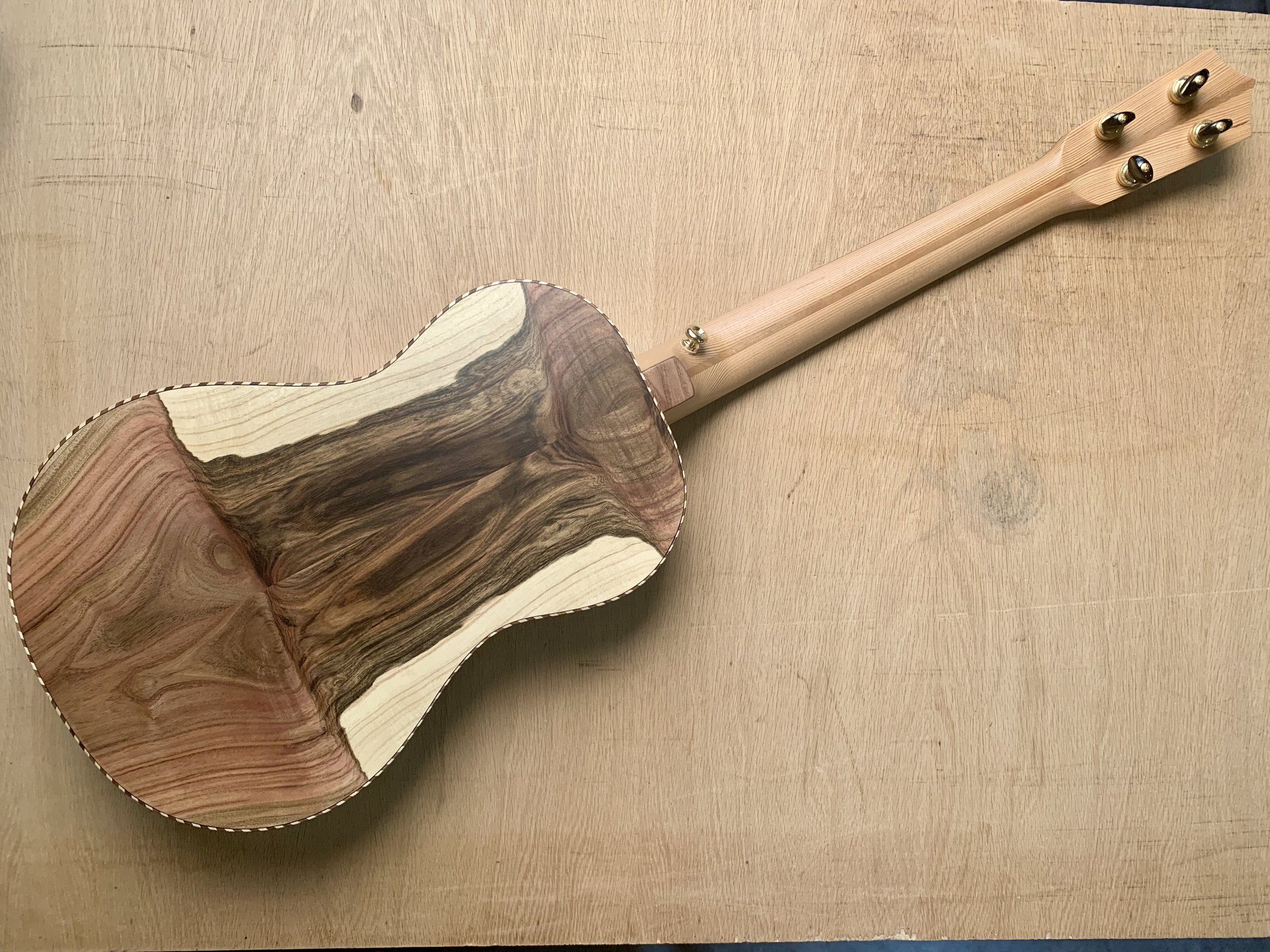I get this curly walnut from Goby in Portland, who specialize in urban forestry and salvage of walnut trees in the Willamette valley of Oregon. Its dramatic curl and rich color palette make it truly special stuff. The pistachio fretboard and trim come from California orchards. Carlos needed a K&K pickup and a wider fingerboard for his tenor scale banjo uke. With Gotoh tuners and fluorocarbon strings, it has a rich but bright tone, great intonation and easy playability. It’s a great musical tool, use it!
#430- Curly Mahogany Tenor Ukulele
This tightly curled mahogany comes from the Carpenter Ant stash in Portland and was likely cut for Lizann’s grandfather to make clocks. I immediately recognized it as the old Cuban mahogany that many early 20th century instrument makers prized. This board is also special because it contains dozens of tiny pin holes from some sort of beetle. It is fun to fill them but leave them as an up close decorative feature. The neck is African mahogany, salvaged from a furniture maker. The pistachio is from California orchards. It’s all wrapped up in old style rope binding. A classic look and sound!
#429- Curly Myrtle Alto Ukulele
I was lucky enough two years ago to find some boards that were wide enough to make alto ukuleles with one piece tops and backs. They make for asymmetrical and wavy looking instruments and have become popular with customers. This one looks and sounds great and I’m happy to send it to Cindy so she can make her own music with it. The Myrtle is salvaged from a furniture maker, the Douglas fir neck is made from old floorboards and the pistachio comes from California orchards.
“Got my uke today and all I can say is awesome, beautiful!!! Just love it, great workmanship. The shallow C neck is great for me.
Love to stroke it since it feels like silk. Very pleased.
-C. W.”
#439- Spruce and Spalted Myrtle Scout Ukulele
Another sweet, democratic and fun Scout ukulele. The top is choice old growth spruce and the back and sides are amazing spalted Myrtle from the Oregon coast. For the fretboard, I am trying persimmon, which I got from another builder. Also called white ebony, persimmon is a great domestic hardwood suitable for luthiery. The neck is old growth Douglas fir, salvaged from some stair treads.
“Hello Keim family,
We received our Scout ukulele (#439) yesterday. My wife, Marsha, loves it. She thinks it’s just adorable and I gotta agree. It’s a beauty! And it sounds great too, it really pops! So now I can hardly wait for my tenor uke - I’m on Aaron’s January build list. Thanks again.
- C. P. ”
#423- The Wayfinder Ukulele
This instrument is not built for a customer, it is built to be passed from player to player over a 2+ year adventure. Making its way around the world, hopefully inspiring music, art and a global communication. It’s not just an ukulele, it’s a long term art project that includes the music, photos and videos it makes as well as entries in a passport book we include with it. This project was inspired by many travelers, including the Polynesian navigators who found Hawaii, the Madeiran woodworkers who brought the ukulele’s ancestors to Hawaii and our many friends who travel the world making music and art. The top and neck are made from Oregon Douglas Fir, which was a prized wood for Hawaiian canoes when it drifted across the pacific. The back and sides are Hawaiian Koa, highly prized by mainland and island luthiers. The rest of the ukulele is made from Oregon Walnut and Maple, including the old fashioned rope binding. Check out the Wayfinder’s website here to keep track of it’s adventures!
#419- Curly Myrtle Baritone Ukulele
At the Carpenter Ant stash, there was a pile of dirty boards that we had to step over every time we picked out wood. Finally, I said “I’m sick of stepping over these. I don’t know what it is, but I’m throwing it in the truck so it’s out of the way.” When I got home, I planed an edge and realized it was Myrtle! Thank you very much. It turns out this particular Myrtle set is far fancier than I anticipated, it’s almost Mastergrade. It looks great neatly presented with no binding and rosette, a straight grain pistachio fretboard from California orchards and a mahogany neck salvaged from the scrap heap at a furniture maker’s shop. It is loud but mellow, a perfectly balanced baritone.
#417- Clockmaker’s Koa Tenor Ukulele
This ukulele includes some very traditional components which were fun for me to work with. First, it has a mahogany neck, which is common on classic ukuleles. I normally don’t use much tropical wood, but this mahogany was scrap from a furniture maker’s shop. Also, the body is made from Koa, which has been a favorite of luthiers looking for a traditional ukulele sound. To put my spin on it, I wrapped it up in Pistachio from California orchards. The Koa is Clockmaker’s Koa from the Carpenter Ant stash in Portland. These boards were set aside decades ago by Lizann’s grandfather for making clock cases. I am blessed to use it for musical instruments today.
#416- Bearclaw Spruce and Pistachio Tenor Ukulele
This tenor ukulele is on its way to Switzerland, which got me thinking about my job as a curator of wooden bits, destined to be combined into an object that then makes music. The spruce is salvaged old growth from Alaska, the amazing grafted pistachio comes from California orchards and the old growth Douglas fir was pulled out of a pig barn in The Dalles, OR. I then labor to make them fit together in the most functional and beautiful way that I can, send it off and hope that it lands in good hands. Bon voyage.
#418- Curly Maple Mini Five String Banjo
Most folks seem to want a “stock” model from me with maybe one change or upgrade. Gene had a vision though and it was fun to try to help him reach it while staying within my own limits and boundaries. Curly maple from the Carpenter Ant stash, lightly stained with amber and extra round over shaping on the edges. He also wanted ball shoe hardware (from Brooks Masten), a frailing scoop, a fifth string hook to change tunings, a goat skin head and a brass arm rest. In the end it turned out great and I have been having fun playing it in the shop. I hope it lives up to his vision! The simple but subtly beautiful pistachio cake from California orchards.
#422- Curly Myrtle Alto Ukulele
I love selecting curly, multi color Myrtle because it matches so well with the pistachio wood. It makes for a wild design that looks even better close up, as you see the endless detail these woods offer. Even though Myrtle sounds great, I know most folks pick it because of how it looks, which is fine by me. Good thing it has such a balanced tone and nice volume to boot. The Myrtle for this came from a pile of cut offs I inherited from Char before she retired. The pistachio is from California orchards. The fir neck is salvaged from a pig barn in The Dalles.
“Just to let you know that the beautiful Myrtle Sisters (422 & 410) arrived yesterday in Point Roberts as promised, and we drove down to Point Roberts this morning to pick them up, and we are all at home now in Steveston and VERY HAPPY.
They are beautiful and sound wonderful and we thank you very much. We had them delivered to a package pick up service. It was thrilling to open the box and see how stunning they are. But then we tried them out in the waiting room and people came out of the back room to hear what the beautiful music was all about! (Invited us to come back every day and play. And we aren’t even that good. Yet.) We’re both really looking forward to getting to know them.
- M. W. ”
#421- Curly Oak Concert Banjo Ukulele
This awesome quartersawn white Oak was milled many years ago to be used for grandfather clocks, but it also serves well for a banjo. I like the tone of oak, sort of halfway between walnut and maple. I hope more folks order Oak from me so I can use it again, it was a pleasure to work with. The oak came from the carpenter ant stash in Portland and the pistachio came from California orchards.
#410- Myrtle Tenor Ukulele
The all Myrtle tenor ukulele has been looking smart, playing easy and sounding good for many years. Tried and true for you as a musical companion and me as a solid piece of work I believe in. This Myrtle is all un-matched parts left over from Char when we worked at Mya-Moe. The pistachio fretboard, bridge and headplate are from California Orchards. The old growth hemlock neck is salvaged from a barn in The Dalles and features a bit beautiful knot.
“Just to let you know that the beautiful Myrtle Sisters (422 & 410) arrived yesterday in Point Roberts as promised, and we drove down to Point Roberts this morning to pick them up, and we are all at home now in Steveston and VERY HAPPY.
They are beautiful and sound wonderful and we thank you very much. We had them delivered to a package pick up service. It was thrilling to open the box and see how stunning they are. But then we tried them out in the waiting room and people came out of the back room to hear what the beautiful music was all about! (Invited us to come back every day and play. And we aren’t even that good. Yet.) We’re both really looking forward to getting to know them.
-M. W. ”
#420- Walnut and Pistachio Concert Banjo Ukulele
Even though I have made many of this model, I love the small differences that make them unique. For this one, the mosaic style block rim made from neck cutoffs and the five piece neck really catch my eye. The walnut is from the Carpenter and stash in Portland and the pistachio is from California Orchards.
#411- Spruce and maple alto ukulele for Camp Westwind
Camp Westwind in Otis, OR is one of our favorite places. We have been there several times for Tunes in the Dunes. I have been lucky to take home spruce, maple, oak and hemlock from the site which I have used in several instruments. This alto ukulele will be auctioned at Tunes in the Dunes to benefit Camp Westwind. The spruce top, neck and braces come from Camp Westwind. The curly maple back and sides was from Char from Mya-Moe and the walnut fretboard and binding are from Goby.
#415- Curly Myrtle Scout Ukulele
A charming little Scout uke, a democratic music making tool, a perfect travel companion. Curly Myrtle body made from scraps I hoarded while working at Mya-Moe. Old growth Douglas fir neck and pistachio everything else. It will be for sale at the Port Townsend Ukulele festival later this month.
#414- Walnut and Pistachio Tenor Banjo Ukulele
I don’t really work in batches, as I always have the next two months of instruments creeping along behind, but I do promise what month you will get your uke in. It feels good to get a month finished and take a little time to refocus, take inventory, clean the shop and dive back in. I am interested in how the rhythm of a working life is interrupted by problems or issues and how they take your focus and time. It’s like a problem child in the class room causing the teacher to leave other students to be more independent. In the case of #414, we had such a good student that it took till today to notice its gifts. Beautiful, loud tone (but not harsh), simple grain and lines with tiny textures and features that draw the eye and a classic shape. The walnut is from the Carpenter Ant stash in Portland and the pistachio comes from California orchards via woodfromthewest.com.
#413- Maple and Pistachio Tenor Banjo Ukulele
Lately I’ve been thinking about consistency in the shop. Not just making a nice thing, but making a nice thing everyday, with repeatability and increased efficiency. I’ve noticed over the last few years that when I gain some time due to efficiency or greater skill, I just end up re-investing the time back into the instrument. I pretty much make a banjo uke in the same amount of time as I did 8 years ago, but the complexity and quality is much greater now. The tricky part is knowing when to start over or give up on a piece of wood. In this case, I admit that I threw away the first neck I made for this banjo and I don’t regret it. As we used to say when I worked as a stage hand: “admit it, fix it and move on.” The maple for this neck comes from Henry’s dance floor stash, the rim is made from the neck cutoffs saved from several other banjos, segmented together in a random mosaic of maple and pistachio. The pistachio fretboard, headplate and trim are from California orchards.
“My beansprout banjo ukulele arrived safely yesterday! It is absolutely stunning. Pictures don’t quite capture the beauty of this instrument. It is such a joy to just hold and look at. I really love the maple and pistachio mosaic drum and the spalted pistachio heel cap. Amazing craftsmanship.
I have logged several hours of playing time since the banjo ukulele arrived yesterday and I really like how comfortable the neck is and how easy the instrument is to play. I was torn between the choice of walnut vs maple but I love the bright punchy sound of the maple. The pistachio rim really balances the sound out nicely.
Thanks again Aaron. Your clawhammer book and youtube videos are what initially inspired me to learn the ukulele several years ago, and I’m just thrilled to have one of your ukuleles now to jam my favorite songs on. Looking forward to many more years of fun and learning with this amazing banjo ukulele.
-T.C.”
#412- Curly Walnut Four String Banjo
I was inspired to make this banjo by an old Vega style F tenor banjo that I used to play. A simple design, a comfortable size, sweet tone and loud volume. I chose the 11” rim from my five string banjos and 20” scale from my Baritone ukuleles so everything would feel familiar, although combined in a new way. This one is strung dgbe with baritone uke strings, but it would be suitable for other tunings and steel strings as well. Curly Oregon walnut from Goby in Portland and the pistachio is from woodfromthewest.com. To see the specs or order, hit the models page.
“The instrument arrived today safe and sound. Wow! It sounds so warm and beautiful, and it’s just gorgeous.
I love it.
I’ve only played for like 45 minutes, but I’m very pleased. I’m new to the baritone scale, so I may circle back with questions. But thanks again for everything. I hope to meet you all in person someday to personally express my gratitude for making such fine instruments.
- D. L. ”
#408- Port Orford Cedar and Myrtle Baritone Ukulele
This baritone sounds just as good as the last one with pistachio back and sides. It might have a little less raw power of sound, but it feels a little more elegant in the lap. It also has a more subtle color palette, featuring the more muted tones of the Wabi-sabi ideal. Old growth Port Orford Cedar, striped Myrtle and Pistachio from woodfromthewest.com and a hemlock neck salvaged from a barn in The Dalles, OR.
“Dear Aaron and Nicole,
I wanted to take a couple of days after I’d received my new Baritone, to sit and play, and to get to know it before I wrote. First let me say, I LOVE IT!!! In fact I’ve been trying to squeeze in extra practice time because it’s such a pleasure to hold it, feel the finish, and the smoothness of the neck makes playing such a wonder.
I love the beauty of the workmanship. The details are exquisite, especially along the fretboard, rope binding, etc. etc. etc. The over all weight is perfect (light) and the balance is amazing. I have an old Giannini baritone, that I love the sound of but the weight is weird/unbalanced and the fret board/neck is a narrow “C” shape that is at times very challenging to play. The slight radius of my new Beansprout Baritone’s fretboard and the fact that the string height is set and adjusted has made making barred chords so much easier.
I guess the one thing I’d have to say that your ukes should come with a warning, “Beware that you will want to play longer and finger soreness may develop”: All kidding aside, everything about the subtle sound and color, the wabi-sabi inclusions, make for a “well worth waiting for” experience. I also loved seeing the pictures and the final video when it was complete. This new Baritone #408 is a dream. I look forward to many years of playing. My only dilemma now is how long can I wait before I order a low G tenor?
Thank you and All the best,
- B. F. ”
#405- Spruce and Pistachio Baritone Ukulele
I love to be surprised. I picked out the wood for this one months ago, but I never took the time to really appreciate it till today. What looked like a plain spruce top ended up having multiple tiny bear claw marks that added an interesting texture to the straight grain dulcimer spruce top. I knew the pistachio back and sides were nice, but now I see how awesome they are. The multi color grafted wood is just stunning. Also, it’s dense and hard nature is perfect for reflecting the sounds from the softer spruce top. So choice. Of course, the pistachio fretboard is a winner too. The pistachio all comes from California orchards, the old growth fir neck is from a floor joist and the Sitka spruce top is salvaged from a 1960’s dulcimer maker’s stash.
“Aaron, I wanted to let you know my ukulele arrived safely yesterday. It looks and sounds awesome! I am totally pleased. I made a short video of me messing around with different versions of Ferre Jacques.
- J. M. ”








































